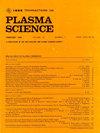各向异性电离层中高频振荡产生VLF波的辐射理论
IF 1.3
4区 物理与天体物理
Q3 PHYSICS, FLUIDS & PLASMAS
引用次数: 0
摘要
近几十年来,利用大功率高频(HF: 3 - 30mhz)电磁波加热电离层已成为一种新兴的极低频(VLF: 3 - 30khz)信号产生技术。本文提出了一种计算各向异性电离层等离子体中与电喷无关的热波加热产生的甚高频场的解析方法。在各向异性条件下,同时考虑了异常波和普通波的影响,推导了虚拟电离层天线的核,并结合两个高频加热器加热产生的非线性调制电流,直接计算了虚拟电离层天线的VLF辐射。计算表明,加热器频率越低,辐射越强,所产生的甚高频无线电波总是沿背景磁场传播,而与加热器感应电流源的倾角无关。结果表明,在一定频率范围内,微波调制引起的VLF辐射强度仍可能随辐射频率的增加而增加,用该理论预测的场与以往HAARP实验的观测结果吻合较好。本文章由计算机程序翻译,如有差异,请以英文原文为准。
Radiation Theory of VLF Waves Generated by Beating HF Waves in the Anisotropic Ionosphere
Ionospheric heating by high-power high frequency (HF: 3–30 MHz) electromagnetic waves has been an emerging technique to generate very low frequency (VLF: 3–30 kHz) signals in recent decades. In this article, we propose an analytical method to calculate the VLF field generated by electrojet-independent beat-wave heating in an anisotropic ionospheric plasma. By considering the effects of both the extraordinary wave and ordinary wave, the kernels of the virtual ionospheric antenna are derived under the anisotropic condition and are further combined with the nonlinear modulation current induced by beating two HF heaters to evaluate the VLF radiation directly. Computations show that a lower heater frequency would give rise to stronger radiation and the generated VLF radio waves always propagate along the background magnetic field regardless of the dip angle of the heater induced current source. The results manifest that the intensity of VLF radiation due to beat-wave modulation may still increase with the radiation frequency within a certain frequency range, and the predicted fields using the presented theory are found to be in good agreement with the observations in previous HAARP experiments.
求助全文
通过发布文献求助,成功后即可免费获取论文全文。
去求助
来源期刊

IEEE Transactions on Plasma Science
物理-物理:流体与等离子体
CiteScore
3.00
自引率
20.00%
发文量
538
审稿时长
3.8 months
期刊介绍:
The scope covers all aspects of the theory and application of plasma science. It includes the following areas: magnetohydrodynamics; thermionics and plasma diodes; basic plasma phenomena; gaseous electronics; microwave/plasma interaction; electron, ion, and plasma sources; space plasmas; intense electron and ion beams; laser-plasma interactions; plasma diagnostics; plasma chemistry and processing; solid-state plasmas; plasma heating; plasma for controlled fusion research; high energy density plasmas; industrial/commercial applications of plasma physics; plasma waves and instabilities; and high power microwave and submillimeter wave generation.
 求助内容:
求助内容: 应助结果提醒方式:
应助结果提醒方式:


